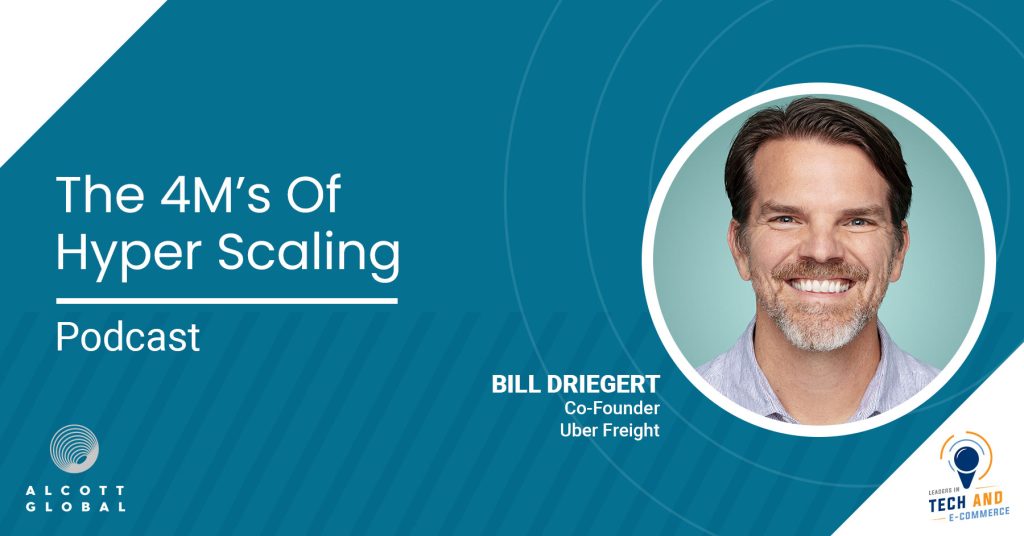Uber Freight seamlessly connects trucking companies with loads to haul. In their own words: “We’re driven by a simple belief. When shippers and carriers have the freedom to move together, the entire industry moves ahead”
According to Silicon Valley’s insider newsletter, The Information, Uber Freight has $500 million revenue run-rate per year and growing.
Prior to joining Uber, Bill spent time at Amazon as Director of Planning and Innovation with oversight over new initiatives in final mile delivery and truckload. And was also a founding team member of Coyote Logistics (acquired by UPS) and the company’s Chief Innovation Officer.
Listen to the full discussion here:
Some of the highlights from the podcast:
- How Uber Freight helps drivers make faster and better decisions through pricing transparency
- The 4M’s of Hyper Scaling- Management, Metrics, Meetings and Messaging
- Over 85% of carriers in the US have fewer than 10 trucks – why does that matter?
- How Uber Freight managed to move 137 loads in the middle of a hurricane.
- 5% of freight being tendered to carriers is being rejected – how is Uber Freight helping solve that problem
- Number one management skills needed for Hyper Scaling
- “It is amazing what you can accomplish if you don’t care who gets the credit.”
Show notes:
- [00:57] Tell us a little about your career and how you ended up leading Uber Freight.
- [01:41] There are 40 companies who started calling themselves Uber for Freight. But I remember putting a PowerPoint together back in 2012 about how we should build Uber for freight and how the execution can be simplified to technology.
- [03:28] How does your pricing model work and how are you able to provide that type of transparency?
- [03:45] Pricing transparency would be a key piece for a variety of reasons. But the simplest way to think about it is it helps drivers make faster and better decisions- to make the market more efficient.
- [05:03] We have a pretty strong signal about demand in a given market. So, if we see that 100 drivers in Portland, Oregon are all looking at one single load, we know that there’s probably high demand for that load.
- [06:23] What’s your biggest problems right now and how are you tackling it- on the operations side?
- [06:37] I think that the core challenges is ensuring that the infrastructure is keeping up with the organization.
- [07:13] The Four M’s of Hyper scaling – Management, Metrics, Meetings, and Messaging.
- [09:46] Trucker shortages are a big problem in the US and Europe, what initiatives are you taking to tackle this?
- [10:19] In almost all markets we look at worldwide, the carrier ecosystem is highly fragmented, in the US, over 85% of carriers have fewer than 10 trucks.
- [11:06] What we see is that drivers are entering the market at a steady pace, but they’re leaving even faster. The number one thing we can do to keep them in the market is to give them more work options and to make the market more accessible.
- [13:14] Through technology and through partnerships with other companies, we can make this whole ecosystem more friendly to drivers and carriers.
- [14:11] Due to the high-impact of the potential risks, corporate accounts tend to choose their freight providers basis (long-term) partnerships. How is Uber planning to disrupt this behavior?
- [16:15] Why we’re having success with shippers is that we’re able to source capacity in any market because we have preferred access to carriers because they’re logging in 24/7 and they know that they’re going to get paid quickly.
- [17:27] One thing to understand from a shipper’s perspective, there is always some rate risk and coverage risk. And it varies depending on how they structured the contracts, but the longer the contract is, the less risk there is.
- [18:53] How do Uber Freight help their clients and shippers tangibly and specifically?
- [20:31] During the time of Hurricane Harvey in Houston Texas, we were able to move 137 loads and it was one individual that was managing all that freight coming in.
- [21:36] Most of the budget creeps within large shippers happens in this kind of unforeseen circumstances, peak moments, holidays or just capacity situations, which may not have been well predicted or forecasted.
- [23:10] 95% of freight being tendered to carriers is being accepted and 4% to 5% is being rejected and we tend to track at the 99% to 100% rate.
- [24:18] What are some of the typical, biggest challenges and biggest points where you need to convince clients to take up the Uber Freight Solution? What tends to be the biggest blockers when it comes to them adopting the platform?
- [25:13] From a shipper’s perspective we’ve had a huge amount of success because people understand the value of Uber. And so they understand that Uber has been able to build out this massive operational capability in personal transportation. So there’s a certain amount of trust that comes with it.
- [28:17] One of the things that I’ve been most impressed with our sales team is their ability to get in the door with so many very large shippers.
- [29:25] How does success look like for you in Europe? How would you measure that? Okay, Uber freight has been very successful at conquering the European market?
- [30:21] One of the advantages that we have when we launched in the US is that we had no debt. We started operations on the same day and we started building the technology. So it took us 7 to 8 months to tech out the door as we were scaling initially.
- [31:45] Success in five years would be to have that Trans European presence.
- [34:23] Are you considering at some point coming to Asia? Or not really?
- [36:00] If you look across the world and where there’s been investment, there are definitely competitors and India, you’ve got BlackBuck and Ravigo. There are similar companies in Brazil and competitors in China.
- [39:21] How do you find and attract the right talent, especially in this high development scale and fast-growing type of environment?
- [41:07] I think being very thoughtful about organizational design, role definition, and scope definition are the core competencies and skills.
- [43:35] The number one way to proactively work around challenges is to be as precise as possible in the role definitions, which requires being thoughtful about strategy, expansion, operational planning and all the rest.
- [44:58] Are there certain principles that you apply to be able to tell if that person is able to grow? What’s your console in terms of identifying whether or not it is a good fit?
- [45:48] The fundamentals of what defines a very entrepreneurial operational leader that could come in and scale a team like that are pretty consistent.
- [46:57] The number one management skill and competency for hyper scaling is delegation and providing autonomy.
- [48:27] What kind of skills would make you stay relevant in the next 5 to 10years?
- [50:29] Consultative selling, being able to think systematically about problems, being able to have those very high-level conversations with carriers and shippers will become more and more important.
- [51:13] What’s the best piece of advice that you’ve received throughout your career?
- [51:24] “It is amazing what you can accomplish if you don’t care who gets the credit.”








